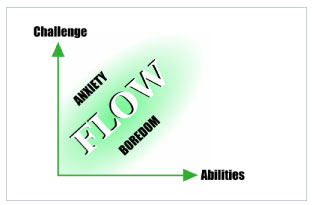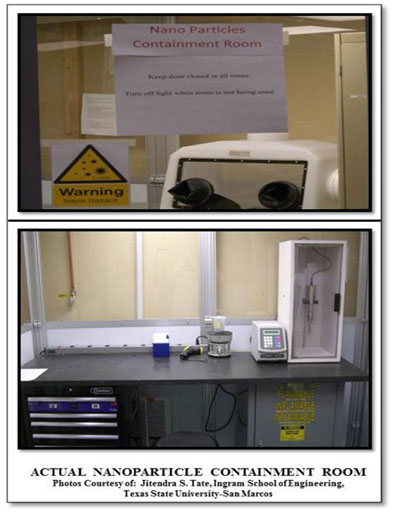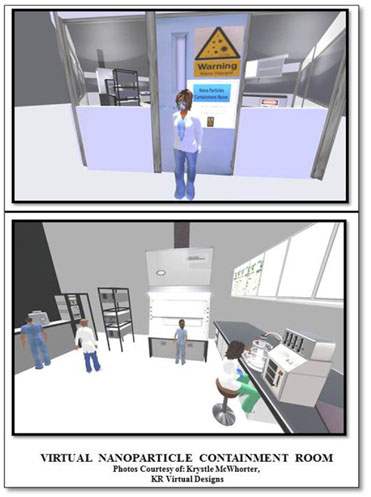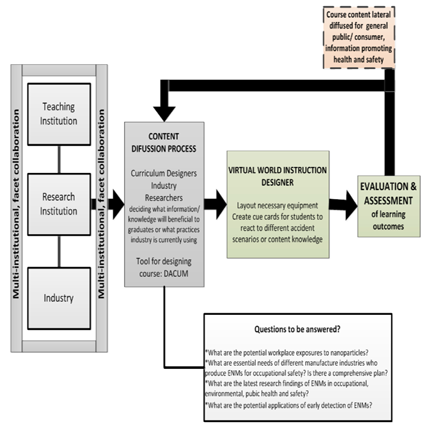JSTE v48n2 - Going Virtual: Delivering Nanotechnology Safety Education on the Web
Going Virtual: Delivering Nanotechnology Safety Education on the Web
Dominick E. Fazarro
Heshium R. Lawrence
Rochell R. McWhorter
The University of Texas at Tyler
Abstract
The emergence of nanotechnology has created new challenges for the 21 st century. Future development of Engineered Nano Materials (ENMs) will soon impact society in ways never imagined before. Most importantly, those who develop and work with ENMs must understand the importance of worker safety. Educators must use creative and innovative ways to educate Generation ‘Y’ to develop a competent nano workforce. We posit that the use of virtual environments in education may be the conduit between Generation ‘Y’s technology connectedness and the teaching of nanotechnology safety education effectively, and cite an example of teaching nanotechnology safety education in a virtual world. In addition, this method of instruction may have implications for engaging higher education students in the STEM area of nanotechnology.
Introduction
The 21 st century presents significant challenges in developing innovative materials and products to remain competitive in a global market. Nanotechnology is a burgeoning new field creating new avenues for developing innovative products ( Feather & Aznar, 2011 ). This new area of science and engineering may be considered the “new industrial revolution” and is expected to impact society like never before ( Holley, 2009 ; Uldrich & Newberry, 2003 ). Further, the Project on Emerging Nanotechnologies (PEN) indicates 1,200 companies, universities, and government laboratories are engaged in nanotechnology research, which is known as the Nano Metro ( PEN, 2009 ).
By 2015, there will be approximately two million workers globally in nanotechnology ( Roco, 2003 ). The makeup of the new workforce will consist of researchers, technicians, manufacturing engineers, and production workers ( NNI, 2009 ). For the majority of educators, nanotechnology is still an ambiguous topic. Toon (2006) , indicated educators had little or no knowledge about nanotechnology. Fazarro (2011) stressed, “[Educators] must appreciate the role nanotechnology will have on society, understand what is required to prepare the nanotechnology workforce, and successfully ‘get the word out’ to students and parents” (p. 208).
Purpose of this Article
The purpose of this article is three-fold: 1) to inform educators in the field about nanotechnology, 2) to build the case for nanotechnology safety education to prepare the workforce for this emerging industry, and 3) to provide a conceptual framework to design and implement nanotechnology safety education in a virtual environment. Each of these three purposes will be described next.
Nanotechnology: The New Frontier
Nanotechnology (“nano”) describes structures of 100 nanometers or smaller ( Lin & Allhoff, 2007 ) and has been defined as “the technology of structuring and controlling matter on the scale of ~100nm and below” ( Van Nedervelde, 2006 , p. 6); an accelerated rate of development of new and innovative products incorporating nanoparticles is occurring. According to Lawrence (2010) , nanotechnology incorporates technology “to make available a fundamental understanding of observable fact and materials at the nanoscale and to build and use structures, devices, and systems that have novel properties and functions because of their small and/or intermediate size” (p. 159). Companies like Proctor & Gamble, LG Electronics, and Siemens are researching structures beginning at the 100 nanometer (nm) boundary ( Lin & Allhoff, 2007 ; NanotechCompanies.us, 2010 ). To attempt to visualize how small nano is, consider the width of a human hair, which is 100 micrometers, and about 50,000, to 100,000 nanometers in diameter; to illustrate with another example, a sheet of copy paper is about 100,000 nanometers in thickness (See Introduction to Nanotechnology, 2007 ; University of Wisconsin-Madison, 2008 ; Wikipedia, 2011 ). For some, it may seem like science fiction, but it is reality and educators should inform others. See Figure 1 for image of nanorice (nanometer) structure.

Figure 1. Image on the left is nanorice composed of non-conducting iron oxide-hematite covered with gold. Image on the right is a magnified nanorice . Used with permission from the Office of Media Relations, Rice University © 2006. Used with permission.
Actually, nanotechnology is not a new concept. According to Harper (2003) , thousands of years ago, the Romans and Chinese used gold nanoparticles to color stained glass. Put into perspective, every time a person lights a match, fullerenes (a 20-hexagonal and 12-pentagonal rings molecule composed of carbon) are produced. Fullerenes are considered a building block of modern nanotechnology (see Van Nedervelde, 2006 ). Nanotechnology materials (“nanomaterials”) are used in contemporary sunscreens, additives in plastics, computing, and textiles ( Nohynek, Lademann, Ribaud, & Roberts, 2007 ).
Developing future engineered nanomaterials (ENMs) is expected to explode with incredible innovations as new nanomaterials are developed and infused for consumer use ( Roco, 2006 ). For example, companies are currently manufacturing auto paints that produce a micro-hardness barrier to resist impacts and scratches. In the medical field, ENMs are being developed to deliver medicines to destroy cancer cells ( Keim, 2005 ). But, pause to consider this question: What is the downside to these incredible possibilities—what are the expected hazards of minute particles on the human body and what does this mean for our workforce?
Nanotechnology Safety
Nanotechnology will likely grow into a trillion dollar market transforming the global economy ( Hsieh, Tsai, Chen, & Chang, 2009 ). When new products are developed, workers’ safety must be considered to prevent harm and litigation. Although there are some (preliminary) guidelines to protect against ENMs ( NIOSH, 2009 ; Trybula & Fazarro, 2008 ), educators are faced with developing curriculum to teach workers how to protect themselves at the nanometer level. Will we have a workforce ready for this coming reality?
Companies that manufacture new ENMs must incorporate safety protocols to ensure worker safety. Today, the growing workforce faces potential exposures, yet lacks reliable information about the specific nature of the risks posed by ENMs, or about how to work safely with ENMs ( Kulinowski & Jaffe, 2009 ; NIOSH, 2009 ).
Safety tools that permit the safe handling of many hazardous materials are based on decades of collecting and publishing ENM data by the National Institute for Occupational Safety and Health (NIOSH) and research communities. However, there is still a need to focus on developing control practices based on the ENMs’ character and levels of exposure for worker safety ( Vishwakarma, Samal, & Manoharan, 2010 ). NOISH (2009) stressed the importance of ENMs that present new challenges to understanding, predicting, and managing potential health risk to workers.
The Future Nano Workforce: Characterizing Generation “Y”
Teaching the upcoming workforce (often referred to as Generation “Y” or “Millennial” students describing those born between 1980 and 2000) has been challenging. Educators reported struggles to motivate these students to achieve the learning outcomes in academic courses ( Eisner, 2004 ). To compound the problem, college students are rarely majoring in STEM areas, leading to critical shortages in the U.S. of the human expertise needed to remain competitive in technological advances ( Atkinson, Hugo, Lundgren, Shapiro, & Thomas, 2007 ). Without an adequate number of STEM majors enrolling into future nanotechnology programs, the United States will fall behind in developing the nano workforce.
Seymour & Hewitt (1997) indicated that, overall, students cannot maintain academic success in STEM fields due to poor teaching, dull introductory courses, lack of encouragement and role models. Dr. Matthias Pleil, Director and Principal Investigator for the Southwest Center for Microsystems Education at the University of New Mexico stressed:
It is imperative we all engage our students to consider a career path in STEM driven careers, particularly the future technicians who will support the micro and nanotechnology workforce. New and innovative delivery of education will keep these tech savvy students engaged so that connections between STEM foundation concepts and their future jobs are clear (Matthias Pleil, personal communication, March 3, 2011).
Infusing Nanotechnology Safety with Education
As generation “Y” or millennial students are constantly connected to technology and are very tech-savvy having grown up with mobile phones, laptops, Xboxes and iPods, even creating their own texting language, they expect their education and work experiences to be integrated with sophisticated technologies ( Larrabee & Robinson, 2006 ). Educators have often reported that these students prefer an environment where they can be immersed into highly focused activities with their favorite sophisticated technologies. This immersion can be considered in light of the theory of flow.
Csikszentmihalyi (2000) defined flow as people being “intrinsically motivated, interested in challenging tasks at hand, being unconscious of themselves while performing the tasks, feeling a unity between consciousness and activities, and oftentimes losing the sense of physical time” ( Csikszentmihalyi, 1990 , pp. 48-66). A person’s Flow experience is achieved when there is a balance between the skill of the participant and the challenges of the activity and skill “refers to an individual’s capabilities to deal with tasks encountered during activities, whereas challenge means the degree to which individuals find it difficult to cope with specific tasks involved” ( Csikszentmihalyi, 1990 , pp. 72-77). See figure 2, The Function of Flow.

Figure 2. Flow Zone as a function of the level of challenge versus the level of abilities as described by Csikszentmihalyi (1998) adapted from “Flow in Games” by J. Chen, Retrieved from http://www.jenovachen.com/flowingames/introduction.htm
Conceptually, the experience of flow transpires when the degree of challenge equals, or is slightly higher than the degree of skill. In addition, if the degree of challenge is in excess of skill, the person may become frustrated, and the person may become bored if the challenge is too much lower than their skill level. Another way to think about flow is to “regard it as a mental mode represented by the combination of some characteristics that individuals experience” ( Shin, 2006 , p.706).
In the context of this article, for example, “Flow represents the extent to which: (1) the user perceives a sense of control over the computer interaction, (2) the user perceives that his or her attention is focused on the interaction, (3) the user’s curiosity is aroused during the interaction, and (4) the user finds the interaction intrinsically interesting” ( Trevino & Webster, 1992 , p. 542).
Researchers Hoffman and Novak (1996) define flow in terms of the experience of flow (intrinsic enjoyment, loss of self-consciousness), behavioral properties of the flow activity (seamless sequence of responses facilitated by interactivity with the computer and self-reinforcement), and its antecedents (skill/challenge balance, focuses attention, and telepresence).
Defining flow provides a direct correlation to the characteristics of generation ‘Y’. Using their strengths, provides an opportunity for educators, especially those who teach safety education, an edge to offer another method of delivering safety education in a way that will naturally fit the Generation ‘Y’ cognitive abilities.
Nanotechnology Safety Education in the Virtual Environment
There is a myriad of choices for the online delivery of training and education available to modern educators. For instance, online training and education courses can be delivered primarily asynchronously (where most or all interaction is not in real-time, but at student and instructor convenience) through the use of Course Management Systems (CMS) also referred to as Learning Management Systems (LMS) on platforms such as Blackboard™, Pearson’s eCollege™, Moodle™, and Sakai™ ( Gilfus, 2010 ). Synchronous (real-time) delivery of training and educational experiences can also be provided through web videoconferencing systems such as Centra™, Cisco’s WebEx™, Adobe Connect™, and Elluminate Live™ delivery systems ( Tucker, 2011 ). It is noted that some platforms (such as Elluminate Live™) can be embedded within a CMS/LMS for synchronous interaction between students and instructor through an integrated approach. Relatively new on the scene for educators, are three-dimensional (3D) virtual worlds such as Second Life™ (SL). Previously used primarily for entertainment, SL and other virtual worlds have been adapted by educators and trainers for synchronous virtual learning and virtual training ( McWhorter, 2010 ; Raisor & McWhorter, 2011 ; Short, 2010 , 2011 ) with approximately 200 higher education institutions world-wide having implemented learning activities in this virtual world ( Molka-Danielsen & Deutschmann, 2009 ).
A recent study in Second Life found the media-rich, highly interactive environment to be conducive for adult learning. This persistent digital world (it will still be online and functioning even if you log off) has many of the enticing graphics of a modern video games but has the ability for users (and educators) to create their own user-made educational content. The researchers of the study remarked that their study participants “recognized social presence—the phenomenon of feeling you are in the same geographical location as others, due to accessing the virtual world through a self-customized avatar and use of gestures thereby facilitating ‘the sense of being’” ( Mancuso, Chlup, & McWhorter, 2010 , p. 690).
Further, Bingham and Connor (2010) noted that virtual worlds such as SL provide a “digital simulated experience” (p. 130) where learners interact with user-made content and other avatars in a synchronous online environment through the use of voice and text chat. Further, they reported that virtual worlds have been useful for virtual field trips, offsite meetings, 3D modeling of buildings, manufactured products and molecular structures, and “when people need training for work in hazardous environments” (p. 131). Such simulated environments have included projects such as the blasting simulations in the University of Derby’s granite quarry, emergency preparedness training simulations, a U.S./Canada Border simulation training for border crossing guards, a simulated coal-firing power plant, a tour through a virtual nuclear reactor, and various military simulations ( Gronstedt, 2011 ).
The rationale for consideration of a virtual world for nanotechnology safety education is four-fold. First, the use of a virtual world poses no physical safety hazards (such as exposure to nanoparticles that might prove dangerous) while a trainee or student is learning appropriate safety precautions through simulated experiential learning in a virtual world ( Gronstedt, 2008 ; Jarmon, Traphagan, Mayrath, & Trivedi, 2009 ). The virtual world provides the student with an “immersive experience in which he or she could not [safely] otherwise venture” ( Kapp & O’Driscoll, 2010 , p. 219). A virtual world environment can provide “PreLab or PreField” experiences such that students gain familiarity with “typical” nano-related environments and potential hazards as well as safety protocols required in the workplace. By interacting within the 3D environment, students will become accustomed to such required safety practices in a novel way.
A second rationale for safety training and instruction in virtual environments is cross-collaboration from various geographical locations. Due to the inherent web-based technologies available in 3D virtual worlds such as Second Life, students from various geographical locations can meet online in one course without leaving their home or office. This practice saves both time and money for students and instructors ( Mennecke, McNeill, Roche, Bray, Townsend & Lester, 2008 ; Short, 2011 ).
Third, the utilization of a virtual world allows the implementation of nanotechnology safety education without the need for expensive equipment at its onset. Not every institution will have access to the state-of-the art equipment or nanotechnology labs at their institution, but through 3D modeling and animation technology available in virtual worlds such as SL, students can become familiar with the appearance, purpose and workings and safety procedures for such equipment. This experiential knowledge will begin the development of a competent nanotechnology workforce.
A fourth rationale for utilizing a virtual world for nanotechnology safety education is due to the fact that virtual environments are easily accessible through existing computer lab infrastructure as well as student access at home; therefore, existing technology and instructors can be leveraged for the new safety courses recommended in this conceptual article with little or no additional expense. However, it is noted that developmental funds may be needed for the design of the virtual environment when instructional technology personnel and instructors do not have the 3D modeling experience needed to create the new nanotechnology lab spaces in virtual worlds.
For the purpose of this conceptual article, we illustrate how an existing Nanoparticle Containment Room at Texas State University-San Marcos has been adapted for instruction within the virtual world of Second Life. Our “proof of concept” can be seen in the graphical representations in Figure 3 below. In this figure, the reader will notice that the upper graphics are actual digital photographs of the containment room at TSU-San Marcus while the two pictures below were taken in the Nanoparticle Containment Room within the virtual world of Second Life. Approximately 50 geographically-disbursed students (via avatar) can participate in a Nanotechnology Safety Course by learning procedures in areas outside the containment room such as appropriate protective gear and safety protocols. The virtual lab itself is equipped with numerous interfaces to web browsers for streaming videos and other learning materials. We envision that once students acquire a basic knowledge of their surroundings and put on necessary safety gear, they will be introduced to the containment room itself.


Figure 3. Depictions of actual nanoparticle containment room in physical and in virtual world settings. Actual Nanoparticle containment room pictures courtesy of J.S. Tate, Texas State University, San Marcos; Virtual nanoparticle containment room pictures courtesy of K. A. McWhorter, Copyright 2011, krvirtualdesigns@gmail.com
Conceptual Model: Multi-Institution Collaboration to Curriculum Design to Virtual Environment
According to ( Genaidy & Karwowski, 2006 ) the pillars of nanotechnology safety education should contain the following:
A roadmap and a guide should be developed for individual health and safety promotion and protection; focus groups should be established to advance integrated solutions and issues of immediate concern to individual health and safety in different nano-manufacturing sectors/environment/disposal activities, and health of public consumers of nano-based products (p.253).
For the purposes of this article, the authors will use the Genaidy and Karwowski (2006) as well as Fazarro (2011) models to illustrate a design for a nanotechnology safety education course. Both models emphasize the education and research elements. Fazarro (2011) used a summative, holistic/multi-institutional collaboration approach to pull the research and teaching oriented institutions and industries together for a nanotechnology safety education program. In addition, this model focuses on the institutions’ strengths to create individual niches to form a synergy for laterally diffusing knowledge for improving the nanotechnology safety education. In contrast, Genaidy and Karwowski’s (2006) model is formative with purposeful objectives for developing a nanotechnology safety education course integrated with the Fazarro (2011) model to create a conceptual framework (See Figure 4) for developing a virtual world course — Introduction to safe handling of nanomaterials .

Figure 4. Conceptual Model for creating a nanotechnology safety course in a virtual world environment. Adapted from “Lateral diffusion of nanoeducation: Developing the new workforce”, by D. Fazarro In J. Light Feather & M.F. Aznar (Eds.), Nanoscience education, workforce training, and K-12 resources, p. 210. Copyright 2011 by Boca Raton: CRC Press. Adapted from “Nanotechnology occupational and environmental health and safety: Education and research needs for an emerging interdisciplinary field of study,” by .A. Genaidy, & W. Karwowski Human Factors and Ergonomics in Manufacturing, 16 (3) pp. 250 & 252. Copyright 2006 by Wiley InterScience.
This model is designed to extract new/cutting-edge knowledge for pushing information into course content. In order for this model to work, educators and industry personnel must be open to ‘forward-thinking’ and ‘out-of-the-box’ thinking in order to address the educational needs in nanotechnology education. The model illustrates the following steps for developing a nanotechnology safety education course: Beginning with feedback through collaboration between industry and institutions, decisions are made as to the content to be presented, then a visual layout of the necessary equipment and instructions by virtual world instructional designer(s) is created followed by the development of evaluation and assessments of learning outcomes with diffusion to the public and consumers for promoting health and safety.
Discussion
In this article we 1) informed educators in the field about nanotechnology, 2) built the case for nanotechnology safety education to prepare the workforce for this emerging industry, and 3) provided a conceptual framework to design and implement nanotechnology safety education in a virtual environment. This article provides a conceptual framework for the designing and implementation of a nanotechnology safety course in a virtual world environment. The authors put forth this article as a ‘future shock’ of things to come as nanotechnology becomes increasingly more prevalent in our society. Collaboration between industry and academia is crucial to developing the new workforce for the 21 st century.
The authors argue that complacency is not an option for educators. As we know, the new generation of learners is challenging to educators across the U.S.; however, this new generation must become our future leaders to sustain the country’s technological edge. Even though educators are diligently pushing toward a more vibrant workforce, there is still a dark cloud looming over the country’s inability to get generation ‘Y’ interested in STEM fields. Post-secondary institutions should develop and diffuse content into curriculum courses using 3D and other motivational means. Furthermore, there is a need to continue research to uncover interventions which will capture the interest and enhance the abilities of the upcoming workforce.
Education in the virtual world for nanotechnology education is a new method and possibly the key for providing a more authentic online learning environment for current and upcoming students who are constantly connected to technology. Although understanding of required nanosafety procedures and actual experience with equipment is ideal, it is not always practical or available, making virtual learning a viable alternative. In addition, to lure generation ‘Y’ students in the STEM disciplines, educators must conform to how generation ‘Y’ socially interacts with technology. Thus, educators must examine and likely redefine their educational philosophies, such as essentialism, progressivism, constructivism and existentialism to incorporate interactive instructional models to maximize the learning outcomes. The reality that all educators must consider is the virtual world is not a panacea, but a viable tool in the educator toolbox to reach out to learners at a distance.
Implications for Further Research
Our next step in the research journey is to begin introducing higher education students into the virtual environment depicted in this article to determine if our “proof of concept” provides positive learning experiences in the area of nanotechnology safety education. Evaluation of the experiences of the students (See Figure 4) will give feedback for the fine tuning (as well as collaborating with experts in the area of nanotechnology) for continued iterations of refinement of the 3D safety education environment model.
A second step on the research journey will involve examining the instructor’s skill set needed when teaching in real-time virtual environments. We suspect that the current competencies for trainers and educators will need to be augmented to work successfully in integrated virtual environments, particularly for those sophisticated technologies with immersive and social characteristics.
Dominick E. Fazarro, Ph.D., is an Associate Professor in the Department of Human Resource Development & Technology at The University of Texas at Tyler. He can be reached at dfazarro@uttyler.edu .
Heshium R. Lawrence, Ph.D., is an Assistant Professor in the Department of Human Resource Development & Technology at The University of Texas at Tyler. He can be reached at hlawrence@uttyler.edu .
Rochell R. McWhorter, Ph.D., is an Assistant Professor of Human Resource Development in the Department of Human Resource Development & Technology at The University of Texas at Tyler. She can be reached at rmcwhorter@uttyler.edu .
References
Atkinson, R. D., Hugo, J., Lundgren, D., Shapiro, M. J., & Thomas, J. (2007). Addressing the STEM challenge by expanding specialty math and science high schools . The Information Technology & Innovation Foundation. Retrieved from http://eric.ed.gov/PDFS/ED506571.pdf
Bingham, T., & Conner, M. (2010). The new social learning: A guide to transforming organizations through social media . San Francisco, CA: Berrett-Koehler.
Csikszentmihalyi, M., (1990). Flow: The Psychology of Optimal Experience . New York: Harper and Row.
Csikszentmihalyi, M., (1998). Finding Flow: The Psychology of Engagement with Everyday Life . New York: Harper
Csikszentmihalyi, M., (2000). Beyond Boredom and Anxiety . San Francisco: Jossey-Bass.
Eisner, S. P. (2004). Teaching generation Y college students: Three initiatives. Journal of College Teaching and Learning 1 (9) 69-84.
Fazarro, D. (2011). Lateral diffusion of nanoeducation: Developing the new workforce. In J. L. Feather & M. F. Aznar (Eds.), Nanoscience education, workforce training, and K-12 resources (pp. 208-211). Boca Raton, FL: CRC Press.
Feather, J. L. & Aznar, M. F, (Eds.) (2011). Nanoscience education, workforce training, and K-12 resources . Boca Raton, FL.: CRC Press.
Genaidy, A. & Karwowski , W. (2006). Nanotechnology occupational and environmental health and safety: education and research needs for an emerging interdisciplinary field of study. Human Factors and Ergonomics in Manufacturing, 16 (3) 247-253. doi: 10.1002/hfm.20051
Gilfus, S. R. (2010). LMS evaluation and review: Course management system evaluations. Educause. Retrieved from http://www.educause.edu/blog/sgilfus/LMSEvaluationandReviewCourseMa/206261
Gronstedt, A. (2008). Training in virtual worlds. Infoline, 25 (803), 1-16.
Gronstedt, A. (2011). Train for Success . Retrieved from http://www.gronstedtgroup.com/site_2011/index.html
Harper, T. (2003). What is nanotechnology? Nanotechnology. 14 (1), 1. doi: 10.1088/ 0957448414001
Hoffman, D. L., & Novak, T. P. (1996). Marketing in hypermedia computer-mediated environments: Conceptual foundations. Journal of Marketing, 60 , 50-68.
Holley S. E. (2009). Nano revolution-big impact: How emerging nanotechnologies will change the future of education and industry in America (and more specifically in Oklahoma) an abbreviated account. The Journal of Technology Studies 35 (1) , 9-19.
Hsieh, F. M., Tsai, P.J., Chen, W.Y., & Chang, P. C. (2009). Developing on-the-job training program for the occupational safety and health personnel in nanotechnology industries. Proceedings of the Industrial Engineering and Engineering Management (pp. 2009-2013). doi: 10.1109/IEEM.2009.5373212
Introduction to Nanotechnology (2007). Retrieved from http://www.understandingnano.com/introduction.html
Jarmon, L., Traphagan, T., Mayrath, M., & Trivedi, A. (2009). Virtual world teaching, experiential learning, and assessment. Computers & Education, 59 , 169-182. doi:10.1016/j.compedu.2009.01.010
Kapp, K. M., & O’Driscoll, T. (2010). Learning in 3D: Adding a new dimension to enterprise learning and collaboration . San Francisco, CA: John Wiley & Sons, Inc.
Keim, B. (2005, July 11). A nanotech cure for cancer? Wired.com . Retrieved from http://www.wired.com/medtech/health/news/2005/11/69206?currentPage=1
Kulinowski, K.M. & Jaffe, M.P. (2009). The goodnanoguide: A novel approach for developing good practices for handling engineered nanomaterials in an occupational setting. Nanotechnology Law & Business 6 (1) 37-44.
Larrabee, A., & Robinson, E. (2006). Ready or not here they come: Motivating and retaining the millennial generation . Retrieved from http://www.belloaks.com/documents/Motivate,%20Retain%20Millennials_BellOaks.pdf
Lawrence, H. (2010). Nanotechnology. In L. Tomei (Ed.), Lexicon of Online and Distance Learning (p. 159). Lanham, MA: Rowman & Littlefield.
Lin, P. & Allhoff, F. (2007). Nanoscience and nanoethics: Defining the disciplines. In F. Allhoff, P. Linn, J. Moor, & J. Weckert (Eds.) Nanoethics: The ethical and societal implications of nanotechnology (pp. 3-16).Hoboken, New Jersey: John Wiley & Sons.
Mancuso, D. S., Chlup, D. T., & McWhorter, R. R. (2010). A study of adult learning in a virtual world. Advances in Developing Human Resources, 12 (6), 681-699. doi:10.1177/1523422310395368
McWhorter, R. R. (2010). Exploring the emergence of virtual human resource development. Advances in Developing Human Resource Development, 12 (6), 623-631. doi: 10.1177/1523422310395367
Mennecke, B. E., McNeill, D., Ganis, M., Roche, E. M., Bray, D. A., Konsynski, B., Townsend, A. M., Lester, J. (2008). Second life and other virtual worlds: A roadmap for research. Communications of the Association of Information Systems, 22 (20), 371-388, Retrieved from http://www.bus.iastate.edu/mennecke/CAIS-Vol22-Article20.pdf
Molka-Danielsen, J., & Deutschmann, M. (2009). Learning and teaching in the virtual world of second life . Trondheim, Norway: Tapir Academic Press.
NanotechCompanies.us (2010). Nanotech Industries . Retrieved from http://www.nanotechcompanies.us/industries.htm
NIOSH, (2009). Approaches to Safe Nanotechnology Managing the Health and Safety Concerns Associated with Engineered Nanomaterials . Department of Health and Human Services, Centers for Disease Control and Prevention, National Institute for Occupational Safety and Health, Publication 2009-125, 104.
The National Nanotechnology Initiative (2009). Nanotechnology: Big things from a tiny world . Retrieved December 15, 2010 from http://www.nano.gov/html/society/Education.html
Nohynek, G. J., Lademann, J., Ribaud, C., & Roberts, M. S. (2007). Grey goo on the Skin? Nanotechnology, cosmetic and sunscreen safety. Critical Reviews in Toxicology, 37 (3), 251-277. doi: 10.1080/10408440601177780
Project on Emerging Nanotechnologies (PEN) (2009). Putting nanotechnology on the map . Retrieved from Woodrow Wilson International Center for Scholars: http://www.nanotechproject.org/news/archive/putting_nanotechnology_on_map/
Raisor, C., & McWhorter, R. R. (accepted). Creation and evaluation of authentic technical writing assignments utilizing virtual world technology . Innovative Research in Virtual Worlds Conference, Coventry University, Coventry, UK, November 3-4, 2011.
Roco, M. C. (2003). Converging science and technology at the nanoscale: Opportunities for education and training. Nature Biotechnology, 21 (10), 1247-28. doi:1016/S0958-1669(03)00068-5
Roco, M.C. (2006, August). Nanotechnology’s future. Scientific American, 295 (2), 39 doi:10.1038/scientificamerican0806-39
Seymour, E., & Hewitt, N. M. (1997). Talking about leaving: Why undergraduates leave the sciences . Boulder, CO: Westview Press.
Shin, N. (2006). Online learner’s flow experience: An empirical study, British Journal of Educational Technology, 37 (5), 705-720. doi:10.1111/j.1467-8535.2006.00641.x
Short, D. (2010). Foreword: Reflections on virtual HRD from a scholar-practitioner. Advances in Developing Human Resources, 12 (6), 619-622, doi:10.1177/1523422310394788
Short, D. (2011). Successful virtual training design and delivery . Pre-Conference Session at the Academy of Human Resource Development International Conference in the Americas, February 23, 2011. Retrieved from http://ahrd.org/displaycommon.cfm?an=1&subarticlenbr=129
Toon, J. (2006). National nanotechnology infrastructure network educates teachers, students and the general public. Retrieved December 13, 2010, from Georgia Tech University, Research News and Publications Office Web site: http://www.gatech.edu/newsroom/release.html?id=875
Trevino, L. K., & Webster, J., (1992). Flow in computer-Mediated Communication. Communication Research, 19 (5), 539-573.
Tucker, C. (2011). Synchronous software scavenger hunts. Experiencing e-learning. Retrieved from http://christytucker.wordpress.com/2011/01/03/synchronous-software-scavenger-hunts
Trybula,W., & Fazarro, D. (2008, Nov) Developing a Need for Nano-Safety: Presenting the Unknowns , presented at the meeting of National Association of Industrial Technology (NAIT) Nashville, TN.
Uldrich, J., & Newerry, D. (2003). The next big thing is really small: How nanotechnology will change the future of your business . New York: Crown Publishing Group.
University of Wisconsin-Madison. (2008) Size and Scale . University of Wisconsin-Madison Materials Research Science and Engineering Center. Retrieved from http://mrsec.wisc.edu/Edetc/nanoscale/index.html
Van Nedervelde, P. (2006). Introducing nanotechnology: Where we are & where we are going . Foresight Nanotech Institute. Retrieved from http://nanotechnology.espaces.com/presentations/General_Introduction.pdf
Vishwakarma, V., Samal, S. S., & Manoharan, N. (2010). Safety and risk associated with nanoparticles-A review. Journal of Minerals & Materials Characterization & Engineering, 9 (5) 455-459.
Wikipedia (2011). Orders of magnitude . Retrieved from http://en.wikipedia.org/wiki/Orders_of_magnitude_(length)